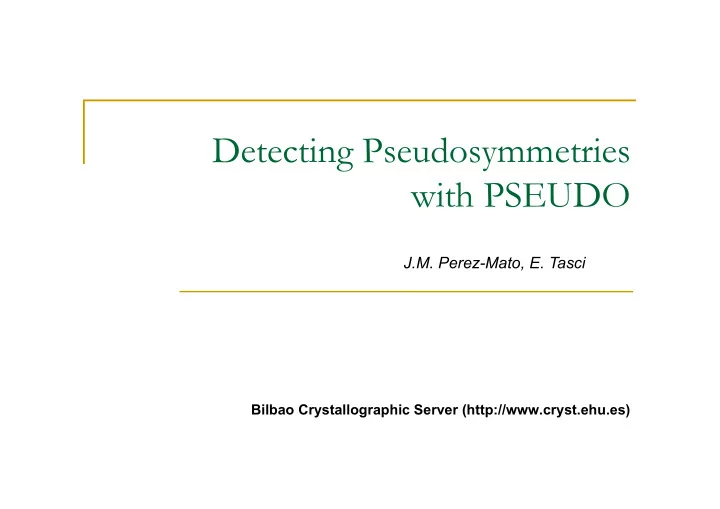

Detecting Pseudosymmetries with PSEUDO J.M. Perez-Mato, E. Tasci Bilbao Crystallographic Server (http://www.cryst.ehu.es)
Bilbao Crystallographic Server http://www.cryst.ehu.es (Main developers of the program: Emre S. Tasci, Cesar Capillas, E. Kroumova)
Problem Given a structure with space group H , finding/ predicting if there is a compatible high symmetry structure of space group G Structure Structure G + small (symmetry-breaking) distortion = H known ?
Pseudosymmetry Search Prototype Structure Initial Structure Structural G G H H Pseudosymmetry ↔ High Symmetry Low Symmetry Distortion If the distortion is small enough, one can infer a symmetry change at high temperature ↓ Phase Transition
PSEUDO Prediction of phase transitions Search for ferroic materials Prediction of the symmetry and structure of some other phase of a material Detection of false symmetry assignments (overlooked symmetry) Space group determination of a theoretically determined structure (e.g. ab initio calculations) Determination of an optimized virtual parent structure (paraphase)
Atomic Displacements Method Assumption: The high symmetry phase is described by a supergroup of the initial space group G = H + g 2 H + … + g m H
Supergroups of Space Groups Any group – supergroup relation can be represented by a chain of minimal supergroups. G > H → G > … > Z G > H G > … > Z 2 > Z > Z 1 > H > H Stepwise detection of pseudosymmetry for successive minimal supergroups.
Supergroups of Space Groups Any group – supergroup relation can be represented by a chain of minimal supergroups. G > H → G > … > Z G > H G > … > Z 2 > Z > Z 1 > H > H If a structure of symmetry H is pseudosymmetric for a supergroup G , it will be pseudosymmetric for all intermediate subgroups Zi Zi .
Example: NaSb 3 F 10 Structural Data Search options Tolerance
Example from the PSEUDO tutorial Space group C222 1
Wyckoff Splitting Compatibility WYCKSPLIT
C222 1 example from the PSEUDO tutorial
Exercise
Polar groups… some additional care u O1 u Ba = 0 u Ti u O1 u O2 u O2 u Ti
Polar groups… some additional care u’ O1 u ' Ba = δ u ’ Ti =u Ti + δ u ’ O1 =u O1 + δ u’ O2 u ’ O2 =u O2 + δ u' Ti u’ O1 u Ba = δ
Pseudosymmetry BaTiO 3
Example: NaSb 3 F 10
Example: NaSb 3 F 10
Example: NaSb 3 F 10 P6 3 / mmc P6 3 / m P6 3 22 P6 3 mc P6 3
P6 3 / mmc P6 3 / m P6 3 22 P6 3 mc P6 3 /mmc P6 3 P6 3 /m P6 3 22 P6 3 mc u=0.70 Å u=0.70 Å u=0.45 Å Na Sb F P6 3 Example: NaSb 3 F 10
Example: NaSb 3 F 10 P6 3 → P6 3 mc → P6 3 /mmc Na Max. Displacement : 0.70Å Sb F
Exercise 3
Search of ferroelectrics as pseudosymmetric polar structures Two necessary conditions to be a ferroelectric: • Polar symmetry group (it should allow non-zero polarization) • Pseudosymmetry with respect to a non-polar symmetry group (the polar distortion should be small and “multistable”)
Known Ferroelectrics with space group Pna2 1
Possible Ferroelectrics with space group Pna2 1
Search of ferroelectrics as pseudosymmetric polar structures (Kroumova et al. 2002) BaHgS 2
“complex” Phase II Ga under pressure Phys. Rev. Lett.93, 205502 (2004)) Space group C222 1 104 atoms per unit cell (divisible by 2, 4, 8 and 13)
Acknowledgements: The past and present rest of the team in Bilbao of the… Present: past: • M. I. Aroyo • D. Orobengoa • J.M. Perez-Mato • C. Capillas • G. Madariaga • E. Kroumova • E. Tasci • S. Ivantchev • G. de la Flor • S. Vidal
Recommend
More recommend